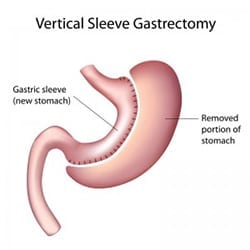
Find out how Vertical Sleeve Gastrectomy can improve your quality of life.
It’s not so easy to shed unwanted pounds, especially if you’re living with a weight that’s significantly beyond what’s considered healthy. Only an option if other attempts to lose weight have been unsuccessful, surgery may dramatically improve quality of life and help control related health issues. One such procedure is a vertical sleeve gastrectomy.
- This procedure shrinks the size of the stomach to the size of a banana
- The technique limits the amount of food needed to make you feel full
How Vertical Sleeve Gastrectomy Works
Performed under general anesthesia, a vertical sleeve gastrectomy takes about 60 to 90 minutes to perform. Referred to as a laparoscope, the surgery is typically done with the assistance of a small camera to better guide the surgeon. Approximately 2 to 5 small incisions are made and a scope and any required instruments are inserted to perform the operation.
A large portion of your stomach will be removed during the procedure in order to substantially decrease its size. The remaining parts of your stomach are surgically joined, usually with a stapling procedure. The muscles that allow food to pass in and out of your stomach are left untouched.
When to Consider Vertical Sleeve Gastrectomy
 Vertical sleeve gastrectomy may be recommended if you fall into the obese category with your weight. It is not a procedure recommended for people who are only slightly overweight. It’s also not a quick fix solution for weight loss. Be prepared to significantly change your lifestyle.
Vertical sleeve gastrectomy may be recommended if you fall into the obese category with your weight. It is not a procedure recommended for people who are only slightly overweight. It’s also not a quick fix solution for weight loss. Be prepared to significantly change your lifestyle.
Ideal candidates for the operation generally must have a body mass index of 40 or higher or be more than a hundred pounds over their recommended weight. BMI ranging from 18.5 to 25 is considered normal. According to the Centers for Disease Control and Prevention, excessive weight increases the risk of:
- Developing conditions like type 2 diabetes
- Heart disease and high blood pressure
- Stroke and some forms of cancer
- Liver and gallbladder disease
Only your doctor can determine if you are a candidate for this type of weight loss surgery. After reviewing your medical history, family history, current health, and weight loss goals, your doctor can help you determine if you are a good fit for weight loss surgery and the sleeve gastrectomy.
Prior to the Procedure
 Prior to the procedure, you’ll undergo a thorough physical exam. In addition to a blood test, an ultrasound of the gallbladder is usually performed along with other tests to determine if you’re healthy enough for the procedure. If you have existing conditions like diabetes, you’ll be encouraged to make sure those conditions are under control prior to surgery.
Prior to the procedure, you’ll undergo a thorough physical exam. In addition to a blood test, an ultrasound of the gallbladder is usually performed along with other tests to determine if you’re healthy enough for the procedure. If you have existing conditions like diabetes, you’ll be encouraged to make sure those conditions are under control prior to surgery.
Let the doctor know if you are pregnant and discuss any medications you may be taking, including over-the-counter drugs, herbal supplements, and vitamins, prior to the procedure. Some things, like pregnancy, make you ineligible for the procedure. You may be asked to stop taking certain medications in advance of the operation to minimize the risk of interactions with medications required for the surgery.
There will be a point just before the operation when you’ll be asked to stop drinking and eating. You’ll be given any other instructions specific to your situation. You may also be encouraged to:
- Start an all-liquid diet a few weeks prior to surgery to shrink the liver and make surgery safer
- Get loose clothing to wear after the procedure
- Stop smoking and drinking alcohol
Be sure to follow your doctor’s surgical instructions very carefully as you prepare for the procedure.
After the Procedure
 Most patients go home a few days after the procedure. Expect to drink mostly liquids at first before going to a pureed diet consisting of foods that require no chewing, which also means easy digestion. Typically, this includes foods like mashed potatoes and pudding. Milk, juice, or water may be added to certain foods to achieve the proper consistency.
Most patients go home a few days after the procedure. Expect to drink mostly liquids at first before going to a pureed diet consisting of foods that require no chewing, which also means easy digestion. Typically, this includes foods like mashed potatoes and pudding. Milk, juice, or water may be added to certain foods to achieve the proper consistency.
When you return to having regular meals, portions should be small to avoid placing added strain on your newly reduced stomach. Some people find that their tastes and food preferences also change after the procedure.
Arrange transportation to come home since driving isn’t recommended right away following the procedure. Have a support team in place to help with tasks like running errands and taking care of more strenuous household tasks during the early days post-surgery. Take on light duties when you return to work until you’re fully healed. Adhere to follow-up instructions and report any unusual pain or discomfort.
The exact steps that you need to follow after your surgery will be tailored to you, so be sure to follow your doctor’s instructions carefully. This will help to improve your chances of having a smooth recovery.
Vertical Sleeve Gastrectomy Outlook
 Vertical sleeve gastrectomy has gained popularity due to an increased dissatisfaction with long-term results of other procedures. It’s often performed as a stand-alone procedure due to success rates that have been observed with the operation, including the fact that many patients lose a significant amount of their weight without the need for any other procedures.
Vertical sleeve gastrectomy has gained popularity due to an increased dissatisfaction with long-term results of other procedures. It’s often performed as a stand-alone procedure due to success rates that have been observed with the operation, including the fact that many patients lose a significant amount of their weight without the need for any other procedures.
VSG is considered a fairly new procedure. However, there is evidence to suggest that a number of patients are able to sustain their weight loss better than with other procedures. Your experience with the operation will depend on several factors, including your existing health and the extent of your weight issues. Not every patient experiences the same results, but your doctor can help you prepare for results that are realistic for your situation.
If other attempts at losing weight have failed, vertical sleeve gastrectomy is a procedure worth considering. Use your initial consultation to ask questions and get as much information about the operation as possible to ensure that you’re comfortable with your decision. If it’s determined that you may benefit from the surgery, you’ll be encouraged to make dietary changes and take other steps to maintain your weight after the procedure to increase your odds of seeing positive, long-term results.
To learn more about vertical sleeve gastrectomy and other weight loss surgery options, contact our office today to schedule your consultation.







